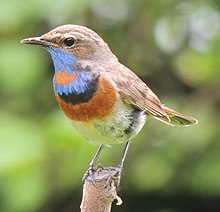Luscinia
| Luscinia | |
|---|---|
 |
|
| Adult male bluethroat (Luscinia svecica) | |
| Scientific classification | |
| Kingdom: | Animalia |
| Phylum: | Chordata |
| Class: | Aves |
| Order: | Passeriformes |
| Family: | Muscicapidae |
| Subfamily: | Saxicolinae |
| Genus: |
Luscinia T. Forster, 1817 |
| Species | |
|
Several, see text |
|
| Synonyms | |
|
|
Several, see text
Luscinia is a genus of smallish passerine birds, containing the nightingales and relatives. Formerly classed as members of the thrush family Turdidae, they are now considered to be Old World flycatchers (Muscicapidae) of the chat subfamily (Saxicolinae). The chats are a lineage of Old World flycatchers that has evolved convergently to thrushes.
The word Luscinia was used for nightingales and similar birds in Classical Latin (e.g. in the AD 70s Naturalis Historia by Pliny the Elder), if not earlier. Etymologically, it might be derived from luscus (Latin for "half-blind", "half-understood" etc.) or clueō (Latin for "to be well-known") + (probably) Latin canō "to sing". Hence, it could be translated as "little-seen [as in the twilight] songster" or "famous songster". The genus Luscinia was introduced by the English naturalist Thomas Forster in 1817. The type species is the common nightingale (Luscinia megarhynchos).
Delimitation of Luscinia versus the genus Erithacus had been confused for long; species were rather indiscriminately placed in one or the other genus, or Luscinia was entirely merged into Erithacus. The genus Luscinia previously included many more species. A large molecular phylogenetic study published in 2010 found that the genus did not represent a monophyletic group. Species were therefore reassigned to other genera leaving only three species remaining in the original genus. The same study showed that the white-bellied redstart, previously placed in the monotypic Hodgsonius, belonged to the same clade.
...
Wikipedia
